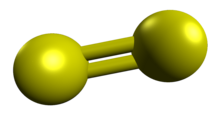Disulfur
 | |
 | |
| Names | |
|---|---|
| IUPAC name Disulfur[1] | |
| Systematic IUPAC name Disulfene | |
| Other names Diatomic sulfur Sulfur dimer | |
| Identifiers | |
3D model (JSmol) | |
| ChEBI | |
| ChemSpider | |
| 753 | |
PubChem CID | |
CompTox Dashboard (EPA) | |
| |
| |
| Properties | |
| S2 | |
| Molar mass | 64.12 g·mol−1 |
| 0 D | |
| Thermochemistry | |
Heat capacity (C) | 32.51 kJ K−1 mol−1 |
Std molar entropy (S⦵298) | 228.17 J K−1 mol−1 |
Std enthalpy of formation (ΔfH⦵298) | 128.60 kJ mol−1 |
| Related compounds | |
Related compounds | Triplet oxygen |
Except where otherwise noted, data are given for materials in their standard state (at 25 °C [77 °F], 100 kPa). | |
Disulfur is the diatomic molecule with the formula S2.[2] It is analogous to the dioxygen molecule but rarely occurs at room temperature. This violet gas is the dominant species in hot sulfur vapors. S2 is one of the minor components of the atmosphere of Io, which is predominantly composed of SO2.[3] The instability of S2 is usually described in the context of the double bond rule.
Synthesis
[edit]This violet gas is generated by heating sulfur above 720 °C, comprising 99% of the vapor at low pressure (1 mm Hg) at 530 °C.
Disulfur can be produced when an atmosphere of COS is irradiated with UV light using a mercury photosensitizer or when CS2, H2S2, S2Cl2 or C2H4S, PSF3 or COS are irradiated.[4]
Natural occurrence
[edit]Gaseous disulfur has been detected emanating from the surface of Jupiter's moon Io, from the vicinity of Pele volcano.[5]
Properties
[edit]The ground state of S2 is a triplet: a diradical, with two unpaired electrons like O2 and SO.[6] It has the S-S bond length of 189 pm, much shorter than the S-S single bonds in S8, which are 206 pm long. Its Raman spectrum consists of a band at 715 cm−1.[7] The corresponding O-O band for O2 is found at 1556 cm−1.[8] The S-S bond energy is 430 kJ/mol compared to 498 kJ/mol for O2.[9]
Singlet disulfur is believed to be the product of trisulfides with triphenylphosphine dibromide, or the thermal decomposition of dialkoxy disulfides. However, the disulfur produced in that reaction is believed singlet because it undergoes formal hetero-Diels-Alder cycloadditions, not because of any spectroscopic evidence.[10]
Triplet disulfur readily photodissociates,[11] with a mean lifespan of 7.5 min in sunlight.[12]
References
[edit]- ^ ebi.ac.uk/chebi/searchId.do?chebiId=29387
- ^ Steudel, Ralf; Eckert, Bodo (2003). "Solid Sulfur Allotropes". Elemental Sulfur and Sulfur-Rich Compounds I. Topics in Current Chemistry. Vol. 230. pp. 58–68. doi:10.1007/b12110. ISBN 978-3-540-40191-9.
- ^ Lellouch, E. (January 2005). "Io's Atmosphere and Surface-Atmosphere Interactions". Space Science Reviews. 116 (1–2): 211–224. Bibcode:2005SSRv..116..211L. doi:10.1007/s11214-005-1957-z. S2CID 121867974.
- ^ Tardif, Sylvie L.; Rys, Andrzej Z.; Abrams, Charles B.; Abu-Yousef, Imad A.; Lesté-Lasserre, Pierre B. F.; Schultz, Erwin K. V.; Harpp, David N. (1997). "Recent chemistry of the chalcogen diatomics". Tetrahedron. 53 (36): 12225–12236. doi:10.1016/S0040-4020(97)00555-3.
- ^ Spencer, J. R. (2000). "Discovery of Gaseous S2 in Io's Pele Plume". Science. 288 (5469): 1208–1210. Bibcode:2000Sci...288.1208S. doi:10.1126/science.288.5469.1208. ISSN 0036-8075. PMID 10817990.
- ^ Greenwood, N. N.; Earnshaw, A. (1986). Chemistry of the Elements. New York: Pergamon; as cited in Harpp, David N. (1997). "The sulfur diatomics". Phosphorus, Sulfur, and Silicon. 120. Amsterdam, NL: Gordon & Breach: 41. doi:10.1080/10426509708545509.
- ^ Eckert, Bodo; Steudel, Ralf (2003). "Molecular Spectra of Sulfur Molecules and Solid Sulfur Allotropes". Elemental Sulfur and Sulfur-Rich Compounds II. Topics in Current Chemistry. Vol. 231. pp. 181–191. doi:10.1007/b13181. ISBN 978-3-540-40378-4.
- ^ Hill, R.A.; Esherick, P.; Owyoung, A. (1983). "High-resolution stimulated Raman spectroscopy of O2". Journal of Molecular Spectroscopy. 100 (1): 119–133. Bibcode:1983JMoSp.100..119H. doi:10.1016/0022-2852(83)90029-2.
- ^ (Lide, David R., ed. (2006). CRC Handbook of Chemistry and Physics (87th ed.). Boca Raton, FL: CRC Press. ISBN 0-8493-0487-3.
- ^ Makarov, Sergei V.; Makarova, Anna S.; Silaghi-Dumitrescu, Radu (2014). "Sulfoxylic and thiosulfurous acids and their dialkoxy derivatives". Peroxides. Chemistry of Functional Groups. Wiley. p. 297. doi:10.1002/9780470682531.pat0829. ISBN 978-0-470-68253-1.
- ^ Frederix, Pim W. J. M.; Yang, Chung-Hsin; Groenenboom, Gerrit C.; Parker, David H.; Alnama, Koutayba; Western, Colin M.; Orr-Ewing, Andrew J. (2009). "Photodissociation Imaging of Diatomic Sulfur (S2)†". The Journal of Physical Chemistry A. 113 (52): 14995–15005. Bibcode:2009JPCA..11314995F. CiteSeerX 10.1.1.511.5087. doi:10.1021/jp905104u. ISSN 1089-5639. PMID 19754091.
- ^ Ahearn, M. F.; Schleicher, D. G.; Feldman, P. D. (1983). "The discovery of S2 in comet IRAS-Araki-Alcock 1983d". The Astrophysical Journal. 274: L99. Bibcode:1983ApJ...274L..99A. doi:10.1086/184158. ISSN 0004-637X.
External links
[edit] Media related to Disulfur at Wikimedia Commons
Media related to Disulfur at Wikimedia Commons


 French
French Deutsch
Deutsch